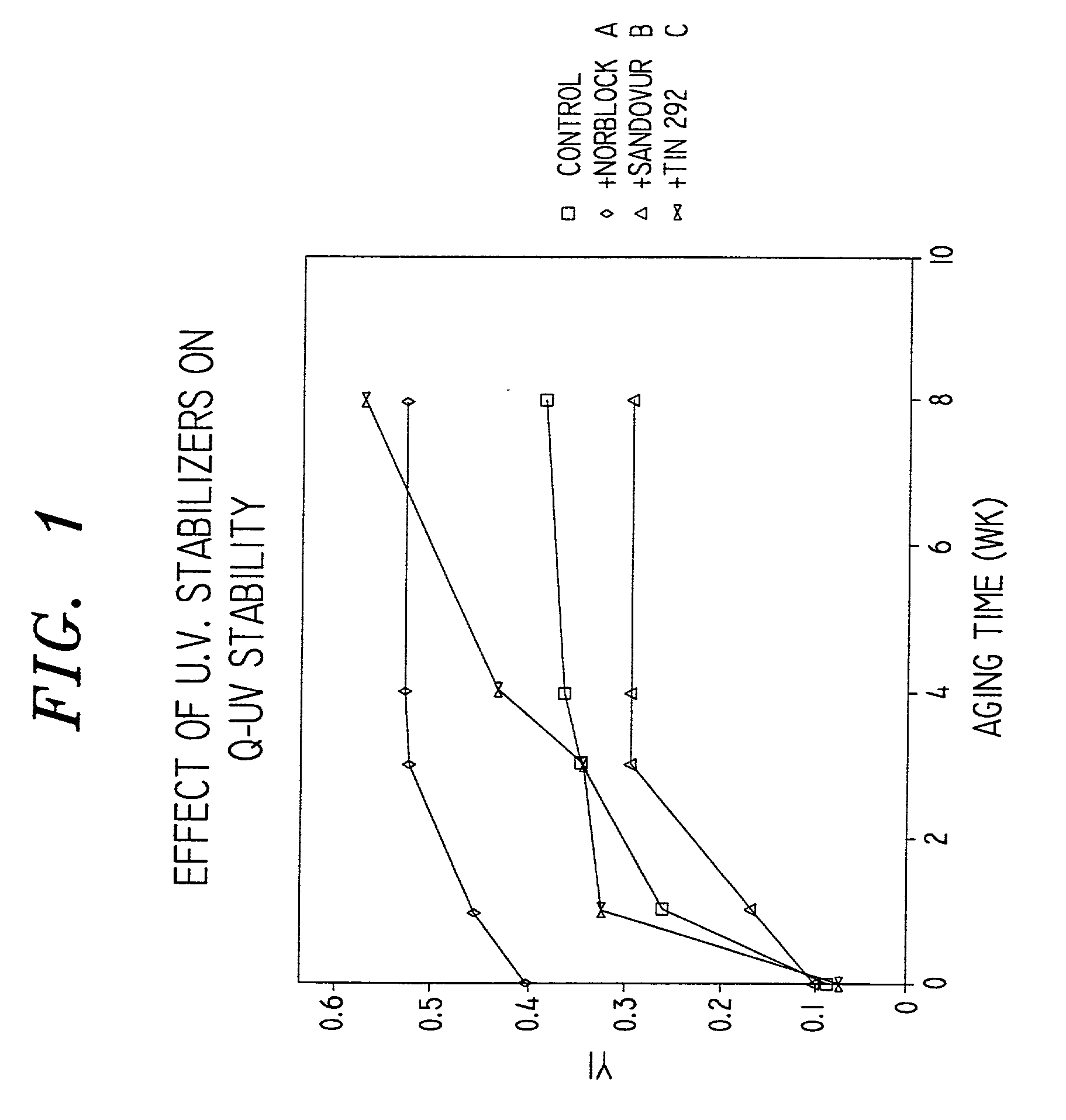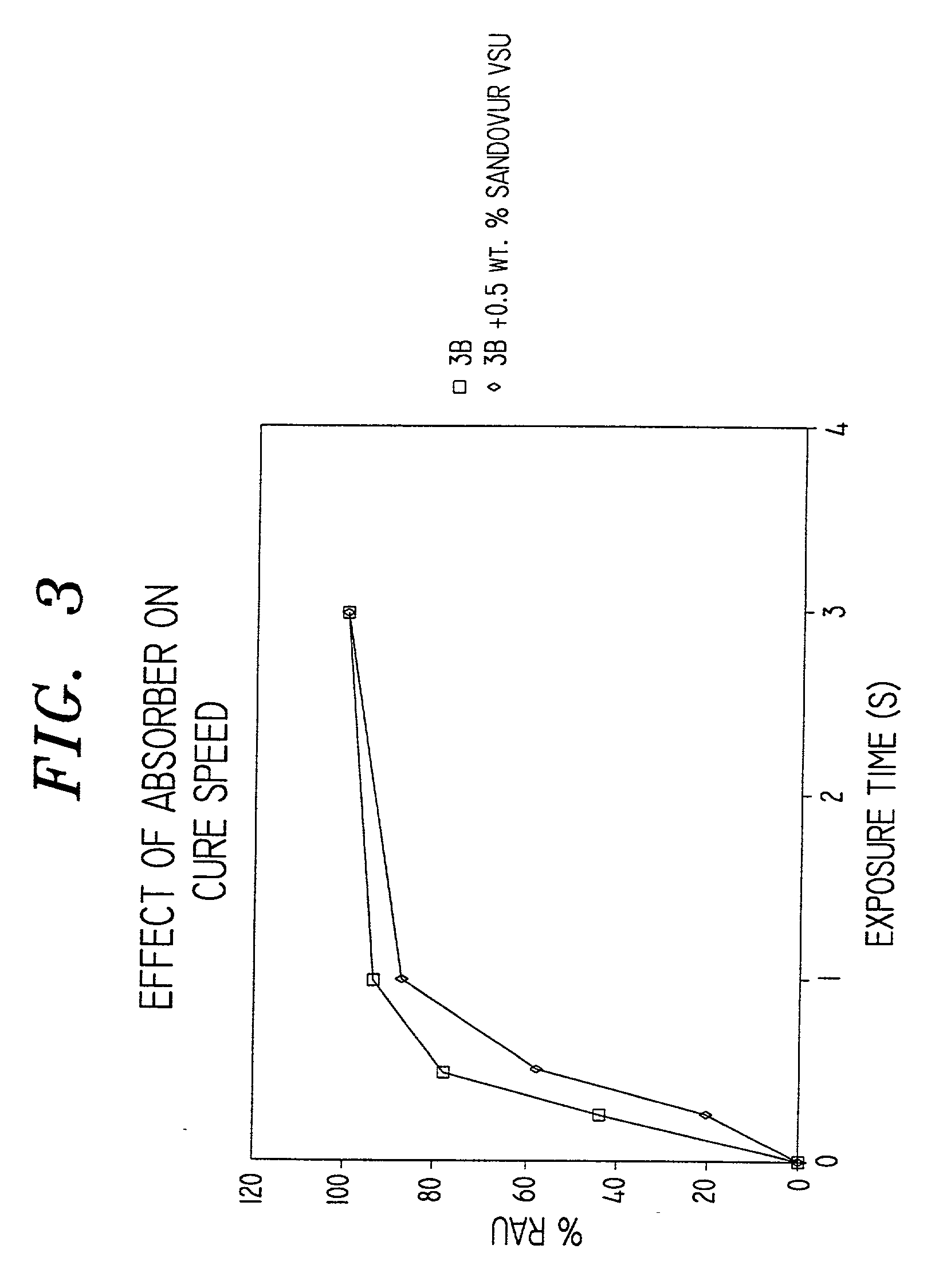Radiation-curable optical fiber coatings having reduced yellowing and fast cure speed
a technology of optical fiber and cure speed, applied in the direction of fibre mechanical structure, coating, transportation and packaging, etc., can solve the problems of inability to cure fast,
- Summary
- Abstract
- Description
- Claims
- Application Information
AI Technical Summary
Benefits of technology
Problems solved by technology
Method used
Image
Examples
example 2
[0173] Formulation of Inner Primary Coatings
[0174] A control inner primary coating composition without UV absorber was formulated from the pre-mixture ingredients summarized in Table II:
2 TABLE II INGREDIENTS AMOUNTS H-(T-PTGL2000).sub.2-T-H.sup.1 50 ethoxylated nonyl phenol acrylate 20.4 lauryl acrylate 7 vinyl caprolactam 6 isobornyl acrylate 13.7 2,4,6-trimethylbenzoyl diphenyl phosphine 1.5 oxide Irganox 1035 0.3 diethyl amine 0.1 mercaptopropyl trimethoxy silane 1.0 .sup.1urethane acrylate oligomer prepared from hydroxyethyl acrylate (H), toluene diisocyanate (T), and a copolymer of THF and methyl-THF having molecular weight of about 2,000 (PTG-L 2,000).
[0175] The control formulation of Table II, which did not comprise UV-absorber, was further formulated into several additional compositions by the addition of additive so that the newly formulated compositions' concentration of additive was 0.5 wt. % (and 99.5 wt. % of composition in Table II).
[0176] The additive for composition...
example 3
[0178] Formulation of Inner Primary Coatings
[0179] Inner primary coatings were formulated according to Table III:
3 TABLE III INGREDIENTS A B H-(I-PTGL2000).sub.2-I-H 51.60 -- H-(I-PPG1025).sub.1.06-(I--- 56 PERMANOLKM10- 1733).sub.1.14-I-H CH.sub.2.dbd.CHCO(OCH.sub.2CH.sub.2).sub.4OC.sub.6 20.87 25.5 H.sub.4C.sub.9H.sub.19 LAURYL ACRYLATE 7.007 -- ISODECYL ACRYLATE -- 14 IRGACURE 1700 -- 3 PHENOXYETHYL ACRYLATE 11.712 -- N-VINYLPYRROLIDONE 4.504 -- IRGACURE 184 3 -- IRGANOX 1035 0.3 0.5 mercaptopropyl 1.001 1.00 trimethoxy silane
[0180] To 99.5% by wt. of each of the above compositions was added 0.5% by wt. SANDOVUR VSU. Film samples were prepared by coating and curing 10 mil films at 1.0 J / cm.sup.2, under a D-lamp (Fusion) in the presence of N.sub.2 and color change was measured at 0, 1, 4, 7, 14 and 28 days. Yellowness Index (YI) was calculated as described below, and delta E values estimated from the yellowness index. The results are provided in FIG. 2. Cured coating compositions ...
example iv
[0182] Cure of Inner Primary Coating Together with Outer Primary Coating Having UV Stabilizer Therein
[0183] Two outer primary coating compositions were formulated from the following pre-mixture ingredients summarized in Table IV:
4 TABLE IV COMPONENTS 4-A 4-B H-T-PTMG650-T-H.sup.1 37.0 37.40 Photomer 3016, 25.0 28.23 bisphenol-A-epoxy diacrylate tetraethyleneglycol diacrylate -- 21.28 triethyleneglycol diacrylate -- 3.45 trimethylolpropane triacrylate -- 6.36 hexanediol diacrylate 10.5 -- isobornyl acrylate 12.0 -- phenoxyethyl acrylate 11.0 -- benzophenone -- 1.49 2,2-dimethoxy-2-phenylacetophenon-e, -- 0.73 Irgacure 651 1-hydroxycyclohexyl phenyl ketone, 1.0 Irgacure 184 2,4,6-trimethylbenzoyl diphenylphosphine 2.0 oxide, Lucirin TPO benzil -- 0.5 diethylamine -- 0.60 phenothiazine -- 0.01 thiodiethylene bis(3,5-di-tert-butyl-4- 0.5 -- hydroxy)hydrocinnamate 2-hydroxy-4-n-octoxybenzophenone -- 0.01 2-hydroxy-4-acryloyloxye-thoxy 0.5 -- benzophenone DC 57, silicone 0.2 0.07 DC 190, ...
PUM
| Property | Measurement | Unit |
|---|---|---|
| thickness | aaaaa | aaaaa |
| thickness | aaaaa | aaaaa |
| speed | aaaaa | aaaaa |
Abstract
Description
Claims
Application Information
 Login to View More
Login to View More - R&D
- Intellectual Property
- Life Sciences
- Materials
- Tech Scout
- Unparalleled Data Quality
- Higher Quality Content
- 60% Fewer Hallucinations
Browse by: Latest US Patents, China's latest patents, Technical Efficacy Thesaurus, Application Domain, Technology Topic, Popular Technical Reports.
© 2025 PatSnap. All rights reserved.Legal|Privacy policy|Modern Slavery Act Transparency Statement|Sitemap|About US| Contact US: help@patsnap.com



